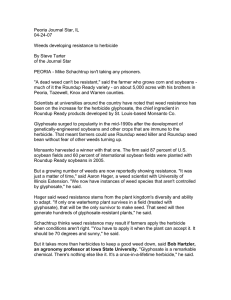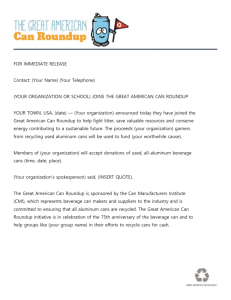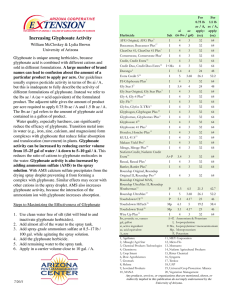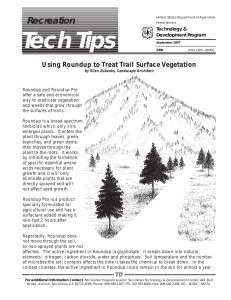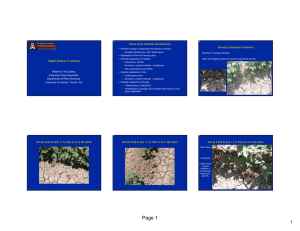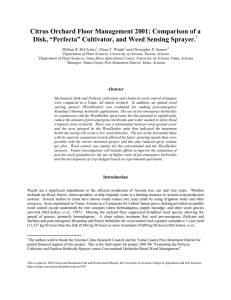Pesticide Notebook
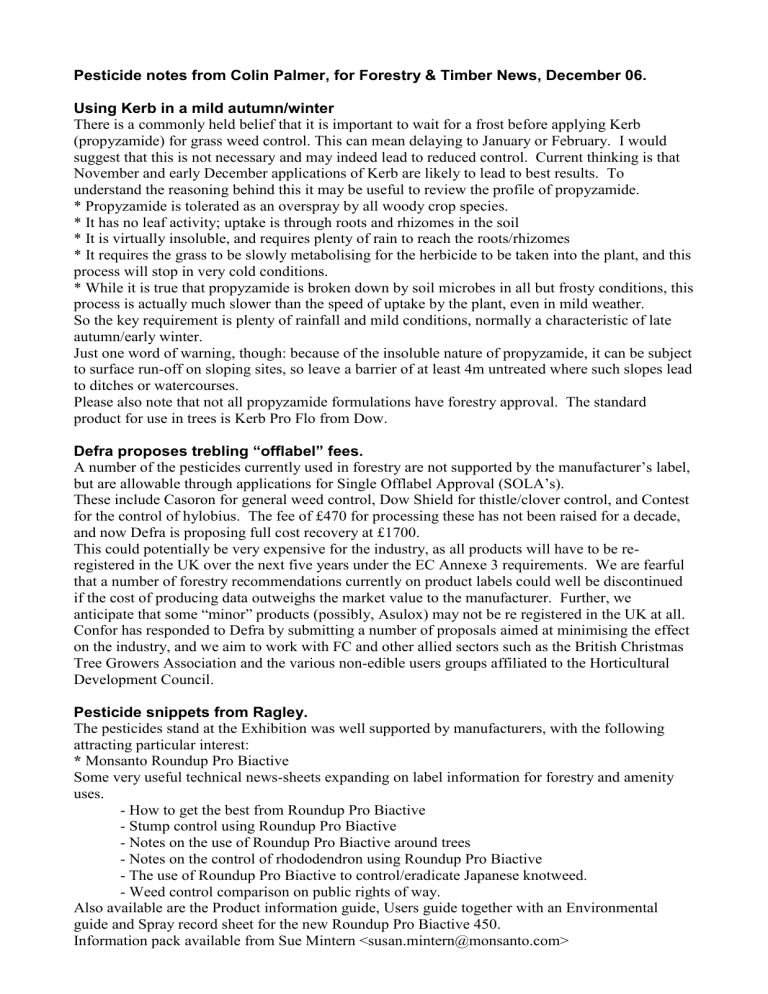
Pesticide notes from Colin Palmer, for Forestry & Timber News, December 06.
Using Kerb in a mild autumn/winter
There is a commonly held belief that it is important to wait for a frost before applying Kerb
(propyzamide) for grass weed control. This can mean delaying to January or February. I would suggest that this is not necessary and may indeed lead to reduced control. Current thinking is that
November and early December applications of Kerb are likely to lead to best results. To understand the reasoning behind this it may be useful to review the profile of propyzamide.
* Propyzamide is tolerated as an overspray by all woody crop species.
* It has no leaf activity; uptake is through roots and rhizomes in the soil
* It is virtually insoluble, and requires plenty of rain to reach the roots/rhizomes
* It requires the grass to be slowly metabolising for the herbicide to be taken into the plant, and this process will stop in very cold conditions.
* While it is true that propyzamide is broken down by soil microbes in all but frosty conditions, this process is actually much slower than the speed of uptake by the plant, even in mild weather.
So the key requirement is plenty of rainfall and mild conditions, normally a characteristic of late autumn/early winter.
Just one word of warning, though: because of the insoluble nature of propyzamide, it can be subject to surface run-off on sloping sites, so leave a barrier of at least 4m untreated where such slopes lead to ditches or watercourses.
Please also note that not all propyzamide formulations have forestry approval. The standard product for use in trees is Kerb Pro Flo from Dow.
Defra proposes trebling “offlabel” fees.
A number of the pesticides currently used in forestry are not supported by the manufacturer’s label, but are allowable through applications for Single Offlabel Approval (SOLA’s).
These include Casoron for general weed control, Dow Shield for thistle/clover control, and Contest for the control of hylobius. The fee of £470 for processing these has not been raised for a decade, and now Defra is proposing full cost recovery at £1700.
This could potentially be very expensive for the industry, as all products will have to be reregistered in the UK over the next five years under the EC Annexe 3 requirements. We are fearful that a number of forestry recommendations currently on product labels could well be discontinued if the cost of producing data outweighs the market value to the manufacturer. Further, we anticipate that some “minor” products (possibly, Asulox) may not be re registered in the UK at all.
Confor has responded to Defra by submitting a number of proposals aimed at minimising the effect on the industry, and we aim to work with FC and other allied sectors such as the British Christmas
Tree Growers Association and the various non-edible users groups affiliated to the Horticultural
Development Council.
Pesticide snippets from Ragley.
The pesticides stand at the Exhibition was well supported by manufacturers, with the following attracting particular interest:
* Monsanto Roundup Pro Biactive
Some very useful technical news-sheets expanding on label information for forestry and amenity uses.
- How to get the best from Roundup Pro Biactive
- Stump control using Roundup Pro Biactive
- Notes on the use of Roundup Pro Biactive around trees
- Notes on the control of rhododendron using Roundup Pro Biactive
- The use of Roundup Pro Biactive to control/eradicate Japanese knotweed.
- Weed control comparison on public rights of way.
Also available are the Product information guide, Users guide together with an Environmental guide and Spray record sheet for the new Roundup Pro Biactive 450.
Information pack available from Sue Mintern <susan.mintern@monsanto.com>
* Headland Amenity Natural Weed Spray No.1
Here is a potential solution to the UKWAS weed control constraints which requires certified foresters to “minimise and eventually eliminate the use of synthetic chemicals”. Natural Weed
Spray No.1 is basically concentrated vinegar (five times normal strength) which will do the same sort of job on weeds as paraquat or low rate glyphosate. And vinegar occurs naturally, so it must be OK!
The only snag is that the approval is only “industrial” at the moment, so we would need to apply for an off-label application for use around trees. Let me know if you feel this would be useful.
Further information from <scott.hutchings@headlandamenity.com>
* Panarex, a new grass herbicide from Certis
Panarex is one of a growing number of grass killers which can be sprayed over broadleaved trees and conifers during the growing season. The product performed extremely well in the demonstration plots at the show, but could prove particularly useful for two otherwise difficult to control weeds creeping soft grass and Calamagrostis epigejos. No forestry or amenity approval exists at present, but an offlabel approval could be applied for if control of these weeds presents more than an occasional problem. Leaflet available from <Benson@certiseurope.co.uk>
* Buttercup control with Junction from Rigby Taylor
Christmas tree growers with a buttercup/plantain/dandelion problem may well find this mixture of
2,4-D and florasulam a particularly useful solution. Although designed as a weedkiller in sports turf, the product may be used as a directed spray in Christmas trees under the Long Term Off-label
Arrangements. Limited work indicates that Norway spruce may tolerate sprays when dormant, although true firs are known to be more susceptible. Product leaflet from
<a.hayes@rigbytaylor.com>
* Glyphosate and nozzle selection demonstrations
Many visitors to the demonstration plots were surprised to find that glyphosate could be effective at rates as low as 0.5l/ha providing a suitable spray quality and adjuvant was selected. Conversely, even high rates of glyphosate failed to perform when applied using coarse droplets in an attempt to reduce drift in gusty conditions.
The Agrimec (Ledbury) stand at the show helped to translate these findings into actions by providing literature on nozzle selection. Probably the most useful of these were the Crop spraying pocket guide” and “Handbook of agricultural spray nozzles produced by Hypro. These books, and supplies of nozzles and spray equipment can be obtained from <guy@agrimec-ledbury.co.uk>
Colin Palmer provides a chemical advice line: any ConFor member may call him for advice and information and it only costs the price of the call. Tel: 01531 633500 or email: forestry@branchline.demon.co.uk
